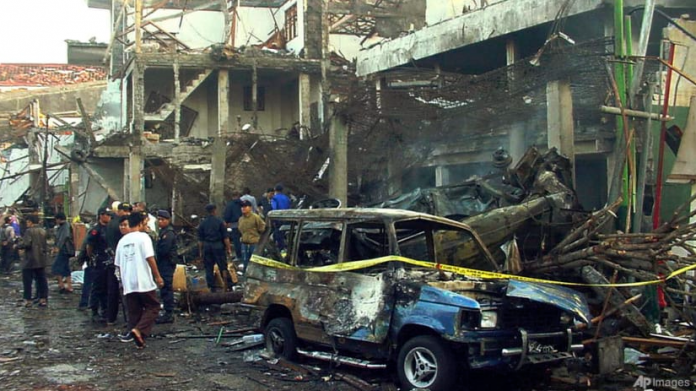Twenty years ago on Oct 12, 2002, the bombing of the Sari Club and Paddy’s Bar on the Indonesian tourist island of Bali killed 202 civilians and sent a shockwave through the region.
The attack perpetrated by the Al-Qaeda-linked Jemaah Islamiyah (JI) terrorist network was actually “Plan B”. “Plan A” had been thwarted about 10 months earlier in December 2001 – JI perpetrators were detained before their planned attack on Western diplomatic missions and commercial interests, as well as local government targets in Singapore.
The JI arrests in Singapore were a severe wake-up call that global terrorism could strike in our own backyard. The Bali bombings were horrific proof that such fears were well founded.
It prompted Southeast Asian governments to invest more extensively in counterterrorism capacity-building, transnational cooperation, and intelligence sharing.
JI was linked to the very same Al-Qaeda global terror network that had perpetrated the mass-casualty suicide attacks involving hijacked commercial airliners in the United States just a few months earlier on Sep 11, 2001.
FOILED SINGAPORE PLOT
The chilling fact that the Singapore plot – like the Bali attacks – would have involved the Al-Qaeda-inspired tactic of using suicide bombers and vehicle bombs certainly did not go unnoticed. This reinforced the reality that JI posed a deadly serious threat.
JI had been set up in January 1993 by Al-Qaeda-influenced followers of the older post-World War II Darul Islam armed separatist movement in Indonesia. Its leaders had established cells in neighbouring Malaysia and Singapore throughout the 1990s, ideologically driven to violently establish a Southeast Asian caliphate spanning southern Thailand to Australia.
Southeast Asian JI fighters had fought or trained together with Muslim combatants from around the world in Afghanistan since the late 1980s, subsequently returning to our region. By the early 2000s, JI began mounting attacks in Indonesia and the Philippines with a view to actualising its Southeast Asian caliphate vision.
AN ICONIC TARGET
For Singapore in particular, the threat posed by JI was not just physical, in terms of the potential of mass injuries and deaths of innocent civilians. There was also the risk that a successful JI attack would cause significant economic and psychological damage.
Because Singapore was – and still remains – a key hub in the global economy, it had long been seen as an “iconic” target by threat groups. An American official told me in June 2002, four months before the Bali bombings: If “a hard target like Singapore” was ever hit, where else in Southeast Asia would then be considered safe?
Global investor confidence would have been severely impacted. Not just Singapore, the region could have suffered capital flight.
It did not help either that some Western policy circles at the time portrayed Southeast Asia as the second front in the George W Bush administration’s “Global War on Terror”. With the admitted benefit of hindsight, this was perhaps an insufficiently granular assessment.
SOCIAL COHESION AT STAKE
More fundamentally, the JI threat of Bali-like attacks in multicultural Singapore also posed a severe social threat. Because JI deliberately justified their actions in the name of religion, there was always the risk that a successful strike in Singapore would destroy social cohesion.
Such attacks could result in anti-Muslim backlash and stigmatisation, as happened in the US after 9/11 or in the United Kingdom after the 2005 London bombing. Deliberately fomenting communal violence in a bid to recruit and radicalise terrified Muslims was very much part of the JI playbook.
It had done this in the religious violence in eastern Indonesia in the late 1990s, and communal strife was what JI had planned to foment within and between Singapore and Malaysia as well.
This is why today’s various grassroots initiatives, ranging from the Inter-Racial and Religious Confidence Circles (IRCCs) to the current SG Secure campaign, have been designed precisely to strengthen the social resilience of Singapore’s multicultural fabric in the event of a terror strike.
A RE-EMERGING THREAT
With the rise of social media today, the tech-savvy propagandists of the Islamic State – an Al-Qaeda offshoot and global rival – promote the current significant threat of self-radicalisation. Violent ideology can thrive in a vast online space that often makes monitoring a deadly cat and mouse game.
Even more recently, the relatively nascent challenge of far right extremism has emerged in Singapore as well.
Adding to the complexity of the threat picture, JI itself, following its near-decimation by regional security forces in the 2000s, is gradually re-emerging, emphasising not violence but rather low-key infiltration of societal and political institutions. Ominously, JI appears to retain regional ambitions.
Twenty years after Bali, the threat of transnational terrorism remains but continues to evolve. So does the need for continued vigilance and not taking our social resilience for granted.
Professor Kumar Ramakrishna is Associate Dean and Head of the International Centre for Political Violence and Terrorism Research at the S. Rajaratnam School of International Studies, Nanyang Technological University, Singapore./ CNA




